Search results for: 'Art'
-
 Cypriot jug with incised decoration
Cypriot jug with incised decorationTypical Red Polished ware from Middle Bronze Age Cyprus, around 2000 BC.
Price: on request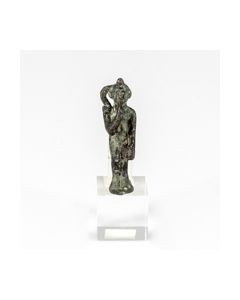 Egyptian bronze figurine of Horus the Child
Egyptian bronze figurine of Horus the ChildAmulet of the child god in half-seated position. In Egyptian mythology his mother protected him by powerful spells. This protection should be extended to the wearer.
Price: on request Luristan bronze figurine of an ibex
Luristan bronze figurine of an ibexMassive bronze pendant in the shape of a standing ibex with long horns. From Iron Age Luristan.
Price: on request Cypriot figure from the archaic period
Cypriot figure from the archaic periodThe cylindrical figure is made of light brown clay and dates to the cypro-archaic period. It is referred to as Snowman type in archaeological literature.
Price: on request Greek clay figurine of a standing woman
Greek clay figurine of a standing womanAbout 6th - 5th century BC. Good condition. From a German private collection, acquired 1976 - 1978 in London.
Price: on request Roman glass bracelet with decorative grooves
Roman glass bracelet with decorative groovesThe glass jewellery from the late Roman Imperial period is decorated on the outside. Made in the Eastern Mediterranean.
Price: on request Bronze Age bracelet with incised decoration
Bronze Age bracelet with incised decorationThe jewellery was made in Europe during the 2nd millennium BC. Nice, dark patina.
Price: on request Near Eastern cylinder seal
Near Eastern cylinder sealThe seal of black stone bears a scene with four noblemen or gods. Late Syrian, around 1500 BC.
Price: on request Corinthian skyphos with harpies or syrens
Corinthian skyphos with harpies or syrensPerfectly preserved vase with frieze showing four harpies or syrens. From an old German private collection, acquired 1978 at Charles Ede Gallery, London. Coming with an ArtLoss certificate
Price: on request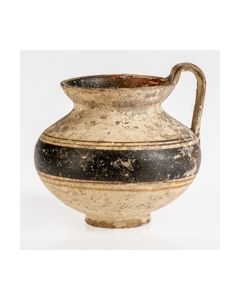 Perfectly preserved hellenistic Chytra from Magna Graecia
Perfectly preserved hellenistic Chytra from Magna GraeciaFrom a German collection, acquired 1970 from Louis Meier, UK (presumably a gallery located in London)
Price: on request Stirrup vessel with lizzards
Stirrup vessel with lizzardsBeautiful vessel from the golden age of the Moche culture. It shows two lizzards on each side. 100 to 500 AD.
Price: on request Roman earrings with shield
Roman earrings with shieldMatching pair of gold jewellery with semi-spherical shield and blue glass bead. From the Roman Imperial period.
Price: on request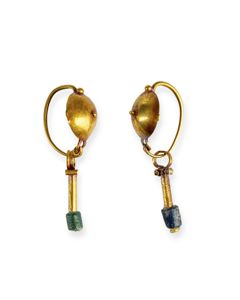 Roman earrings with shield
Roman earrings with shieldMatching pair of gold jewellery with semi-spherical shield and coloured glass bead. From the Roman Imperial period.
Price: on request Near Eastern lance head
Near Eastern lance headDouble-edged blade of a lance from Bronze Age. With a nice green patina.
Price: on request Roman glass bracelet
Roman glass braceletThe bangle or hair ring from the Roman Imperial period is made of dark blue glass. Produced in the Eastern Mediterranean.
Price: on request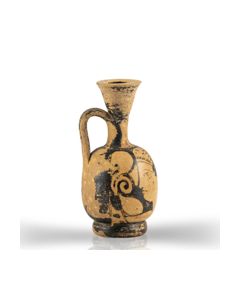 Red-figure Apulian lekythos
Red-figure Apulian lekythosVery good condition, intact and not restored. From an old German private collection, acquired before 1982.
Price: on request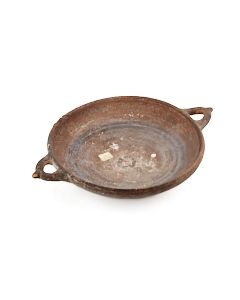 Cypriot bichrome ware dish
Cypriot bichrome ware dishLarge shallow bowl painted with geometrical patterns in dark red and dark brown. Bichrome ware from the Cypro-Geometric period.
Price: on request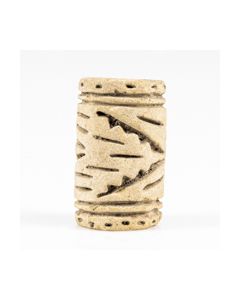 Jama-Coaque roller stamp
Jama-Coaque roller stampClay roller stamp with relief of stylized plants used to apply skin decoration. This tool is from the early phase of the ecuadorian Jama-Coaque culture.
Price: on request Scythian short sword
Scythian short swordThe so-called acinaces is a typical weapon of the Scythians. Well preserved piece from the 7th to 5th centuries BC.
Price: on request Ägyptisches Schutzamulett mit Isis, Nephthys und Horus
Ägyptisches Schutzamulett mit Isis, Nephthys und HorusFayence mit Darstellung der Dreiheit der Götter Isis, Nephthys und Horus. Hervorragende Erhaltung. Vollständig und intakt. Spätzeit des Alten Ägyptens bis Griechisch-Römische Zeit.
Price: on request Akkadian cylinder seal with hero
Akkadian cylinder seal with heroThe cylindrical seal boosts a hero protecting two horned animals from attacking lions. A nice symmetrical composition by the seal engraver. Old Akkadian, around 2300 BC.
Price: on request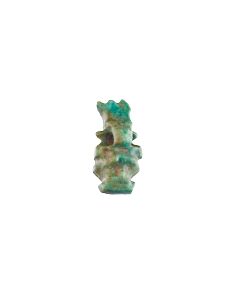 Egyptian amulet of Bes
Egyptian amulet of BesProtective amulet of the dwarf god Bes made of turquoise faience. Nice specimen from Ptolemaic or Roman Egypt.
Price: on request Maya pottery bowl
Maya pottery bowlFlat bowl painted with mythical creatures. From the Classic period of the Maya civilization. Stunning object with lively colours.
Price: on request Egyptian scarab
Egyptian scarabThe scarab is made of nice greenish grey stone. Schematical upper side, structured, unengraved bottom side. From the Late Period of Ancient Egypt.
Price: on request Egyptian scarab
Egyptian scarabThe scarab is made of nicely marbled black and grey stone. Schematical upper side, structured, unengraved bottom side. From the Late Period of Ancient Egypt.
Price: on request Near Eastern lance head
Near Eastern lance headDouble-edged blade of a lance from Bronze Age. Probably from Luristan in North Iran.
Price: on request Two Near Eastern weapon points
Two Near Eastern weapon pointsGroup of two bronze points for small spears or large arrows from the Bronze or Early Iron Age. With a nice green patina.
Price: on request Hellenistic-Roman clay figurine of a standing woman
Hellenistic-Roman clay figurine of a standing womanVery nice condition. From German private collection, acquired 1985 from Aloys Faust, Cologne.
Price: on request Roman glass bracelet with beautiful decoration
Roman glass bracelet with beautiful decorationThe small bangle from the 4th century is decorated with polychrome glass layers on the outside. Made in the Eastern Mediterranean.
Price: on request Roman glass bracelet with spiral decoration
Roman glass bracelet with spiral decorationThe 4th century bangle is decorated with spiraling grooves on the outside. Made in the Eastern Mediterranean.
Price: on request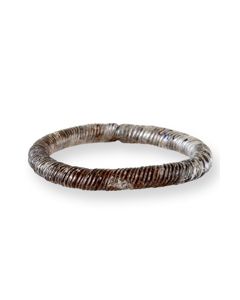 Roman glass bracelet with spiral decoration
Roman glass bracelet with spiral decorationThe 4th century bangle is decorated with spiraling grooves on the outside. Made in the Eastern Mediterranean.
Price: on request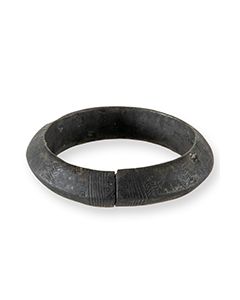 Bronze Age bracelet with incised decoration
Bronze Age bracelet with incised decorationThe jewellery was made in Europe during the 2nd millennium BC. Nice, dark patina.
Price: on request Roman glass bracelet with spiral decoration
Roman glass bracelet with spiral decorationThe 4th century bangle is decorated with spiraling grooves on the outside. Made in the Eastern Mediterranean.
Price: on request Roman glass bracelet with spiral decoration
Roman glass bracelet with spiral decorationThe 4th century bangle is decorated with white spiraling glass inlay. Made in the Eastern Mediterranean.
Price: on request Jama-Coaque roller stamp
Jama-Coaque roller stampClay roller stamp with relief of mythological creatures to be applied as a skin decoration. This tool was used in the early phase of the ecuadorian Jama-Coaque culture and was found in Pedernales.
Price: on request Jama-Coaque roller stamp
Jama-Coaque roller stampClay roller stamp with relief of plants to be applied as skin decoration. This tool was used in the early phase of the ecuadorian Jama-Coaque culture.
Price: on request

